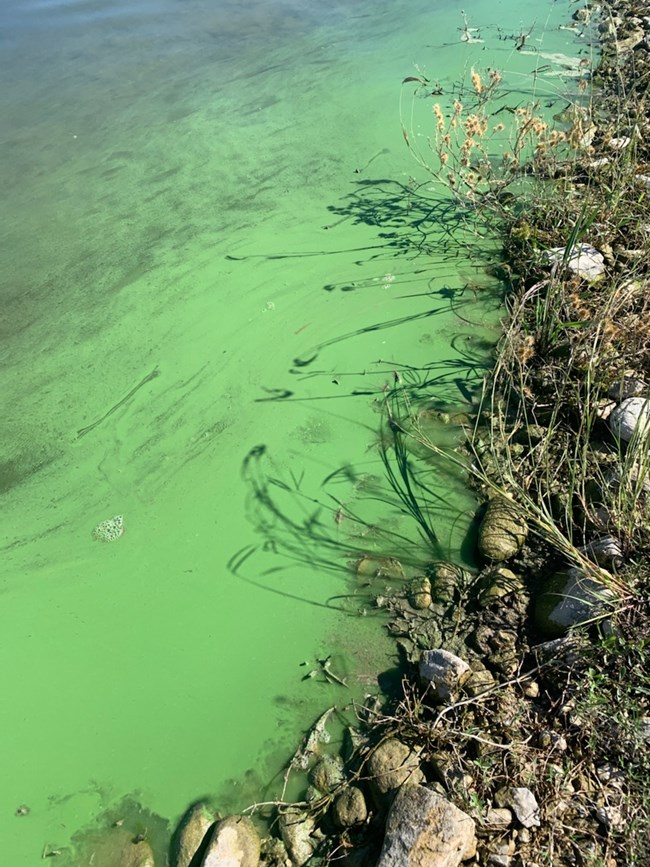
NPS Photo / Rene Rios While not very common at Amistad National Recreation Area, the reservoir does get occasional algal blooms. Read on to learn more about how to identify them, what causes them, and what effects they may have on you and on the lacustrine (lake-related) environment. If you see something in the park that you think matches this description, please contact the Visitor Center and provide contact information (so we can ask questions), location where algae was seen, a photo (if possible), and ask the information be forwarded to a park biologist. What are blue-green algae?Blue-green algae are also called “cyanobacteria” since they are biologically similar to bacteria in many ways. However, blue-green algae (Cyanophyta) are not classified with bacteria because they lack a nuclear membrane. One characteristic of these cyanobacteria is their ability to form blooms so thick it appears that blue-green paint covers the surface of the water. However, the toxins they create may be present days after the algae is no longer visible, so water quality testing is performed to verify water is safe to swim in. Does Texas have blue-green algae?Two forms of blue-green algae are found in Texas: Anabaena and Microcystis. These can produce toxins that are poisonous to fish and wildlife that drink water contaminated with the toxins. Furthermore, there are documented cases of blue-green algal toxins harming humans in other parts of the world through the consumption of poorly treated waters. What causes algae blooms?Blooms can be caused by several factors. An increase in nutrients can cause a dramatic increase in algae growth and reproduction, just as fertilizing a lawn makes grass grow faster. Or, there may be a change in water temperature, water quality, amount of sunlight, or some other environmental factor that gives some algae an advantage over other species of algae, which can result in a bloom of the algae that have the advantage. Harmful algal blooms need:
What do blue-green algal blooms look like?Blue-green algal blooms are often described as looking like pea soup or spilled green paint. However, blooms aren’t always large and dense and can sometimes cover small portions of the lake with little visible algae present. Blooms can also produce a swampy odor when the cells break down. What are the possible health effects?You can become sick if you swallow, have skin contact with, or breathe in airborne water droplets while swimming, boating, waterskiing, tubing, bathing, or showering in water that has harmful algae or if you drink water that contains algal toxins. If you become sick, you might experience vomiting, diarrhea, rash, eye irritation, cough, sore throat, and headache. Symptoms generally begin hours to two days after exposure. Can animals be affected?Pets, especially dogs, are susceptible to harmful algae because they are relatively small and tend to swallow more water while swimming and playing (e.g., retrieving a ball from the water). Dogs may ingest algae if they lick their coats after leaving the water. They are also less deterred by green, smelly water that may contain harmful algae. To reduce your animal's exposure to blue-green algae:
Animals can experience symptoms within minutes of exposure to the toxins. Symptoms they might experience include vomiting, diarrhea, weakness, difficulty breathing, and seizures. In the worst cases, animals have died. If your pet experiences these symptoms after exposure to algae, contact your veterinarian immediately. The World Health Organization recommends the following for all freshwater-based recreation:
Who responds to Harmful Algal Blooms?Texas Parks and Wildlife Department (TPWD) has a Kills and Spills Team (KAST) that responds to an incident where fish or other animals have been harmed. These specially trained biologists collect water samples for analysis, record water quality and environmental data, and identify and estimate numbers of dead wildlife, among other tasks. They contact other agencies and personnel, including Texas Department of State Health Services if human health issues are suspected, Texas Commission on Environmental Quality for impacts to natural resources, and the governing authority that manages a particular area, like the National Park Service for issues with Amistad Reservoir. TPWD monitors harmful algal blooms as they progress and communicates with the public through the agency website and social media accounts. The county, city, river authority, or other agency in charge of an affected area is responsible for cleanup of dead wildlife. Useful Websites:Texas Parks and Wildlife Department (TPWD): https://tpwd.texas.gov/landwater/water/environconcerns/hab/ 

Left image
Right image
|
Last updated: April 21, 2025
